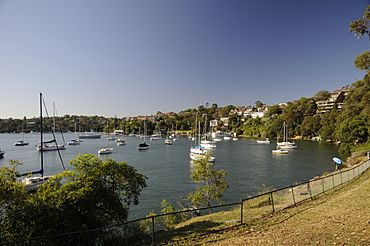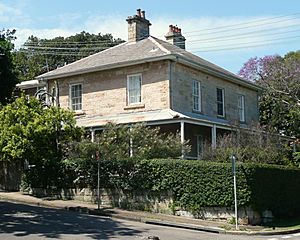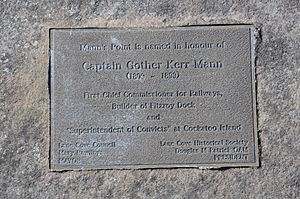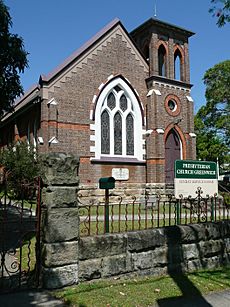Greenwich, New South Wales facts for kids
Quick facts for kids GreenwichSydney, New South Wales |
|||||||||||||||
|---|---|---|---|---|---|---|---|---|---|---|---|---|---|---|---|

View from Shell Park
|
|||||||||||||||
| Postcode(s) | 2065 | ||||||||||||||
| Elevation | 56 m (184 ft) | ||||||||||||||
| Area | 1.7 km2 (0.7 sq mi) | ||||||||||||||
| Location | 7 km (4 mi) NW of Sydney CBD | ||||||||||||||
| LGA(s) | Municipality of Lane Cove | ||||||||||||||
| State electorate(s) | Lane Cove | ||||||||||||||
| Federal Division(s) | North Sydney | ||||||||||||||
|
|||||||||||||||
Greenwich is a suburb in Sydney, New South Wales, Australia. It is located on the Lower North Shore, about 7 kilometers north-west of the Sydney city center. Greenwich is part of the Municipality of Lane Cove.
This suburb sits on a piece of land that sticks out into Sydney Harbour. It is also near where the Lane Cove River meets the harbor. Greenwich offers beautiful harbor views and has some natural bushland areas. You can find shops, restaurants, cafes, and even a swimming pool with a shark net right on the harbor.
Contents
History of Greenwich
How Greenwich Got Its Name
The name 'Greenwich' comes from a famous place in London, England. That Greenwich is located by the River Thames. Long ago, the Parramatta River in Sydney was sometimes called the 'Thames of Australia'. Because of this, other nearby suburbs were also named after places along the River Thames, like Putney and Woolwich.
First People and Early Settlers
The first people to live in the Greenwich area were the Cammeraygal clan. They were part of the Dharug-speaking people of the Eora Nation. They lived along the harbor's edge, hunted in the forests, and traded with other groups.
The first European to visit the area was Lieutenant Henry Ball in 1788. This happened while he was exploring Middle Harbour. Land grants, which are like giving away land, started in 1794. Industries began to grow in the area during the 1830s. Sadly, by the 1860s, many Aboriginal people had left the area due to sickness and being forced from their lands.
Early land was given to Samuel Lightfoot, a convict, in 1794. William Gore, a public servant, received land in 1813. Gore built a road from his farm to Gore Cove. This road was the start of what is now Greenwich Road.
Growing Up: From Farms to Suburb
In the 1830s, George Green and his father, Amaziah, bought land in Greenwich. Their land had access to the harbor. They, along with others, started a shipbuilding business on the foreshore. When George Green divided his land in 1840, the name 'Greenwich' was first used.
Greenwich House is a two-story home made from sandstone blocks. It was built in 1836 on George Green's large property. This house still stands today at the corner of George and St Lawrence Streets. Later, the house was sold to Gother Kerr Mann in 1853. His family owned it until 1949.
The eastern tip of Greenwich is called Manns Point. It is named after Gother Kerr Mann (1809–1899). He was the first Chief Commissioner for Railways. He also oversaw convicts at Cockatoo Island.
By the early 1880s, Greenwich Point had a post office, a general store, and a school. There were about 16 houses. The upper part of Greenwich took longer to develop. Most of it was still wild bushland. As roads improved and more land was divided, some grander houses were built. Greenwich slowly became a suburb where people lived and traveled to work.
Industries and Innovations
Between the 1880s and the 1940s, several successful dairies operated in Greenwich. Families like the Andersons and Hogans ran them. Milk from Anderson's was even delivered by boat.
Light industries also set up along the Greenwich foreshores. These included shipbuilding, brickmaking, and quarrying. Shell opened a fuel terminal at Gore Bay in 1901. It imported and distributed petroleum products. This site grew over time. Today, fuel products unloaded at Gore Bay are sent through an underground pipe to the Clyde Refinery.
Greenwich was also important for a special tunnel. It was the northern entrance of the first tunnel under Sydney Harbour. This tunnel was built by the New South Wales Government Railways. It was meant to carry electricity from the Pyrmont Power Station to the tram network on the north shore. The tunnel was started in 1913 and finished in 1924. It was dug almost entirely from the Greenwich side.
Heritage listings
Greenwich has several places that are protected for their historical importance. These include:
- 95 River Road: Pallister, Greenwich
- Greenwich Infants School
- Sydney Harbour railway electricity tunnel
Education
Greenwich Public School is a local primary school. It has two campuses that are about 1.5 kilometers apart. The school first opened in 1876. It became a public school in 1880. In 1909, the school moved to the site of the current infants school. The primary school moved to Kingslangley Road in 1950. The children of former Prime Minister John Howard attended this school.
Transport
You can get around Greenwich in several ways. The Greenwich Point ferry wharf offers Sydney Ferries services. These ferries travel between Circular Quay and Cockatoo Island. Another wharf on the Lane Cove River has peak-hour services by Captain Cook Cruises.
Busways bus route 265 goes from Lane Cove to North Sydney through Greenwich. There are also regular buses on the Pacific Highway. The closest train stations are at Wollstonecraft and St Leonards.
Sport and recreation
The Greenwich Village Games are held every four years. They feature many sports and competitions. These events mostly take place at Bob Campbell Oval and the Lane Cove Aquatic Centre. The Greenwich Sports Club was started in 1936. It organizes football (soccer) for men, women, and children. It also has netball for girls.
There are two sailing clubs in Greenwich. One is at the mouth of the Lane Cove River. The other is off Greenwich Point. A Scout Hall is located on the eastern side of Greenwich. It is where the Greenwich/Wollstonecraft Scout group usually meets. Other local groups also use this hall.
Demographics
At the 2021 census, there were 5,469 people living in Greenwich. Most people, about 62.7%, were born in Australia. Other common birthplaces included England (5.6%), China (2.9%), India (2.3%), and New Zealand (2.2%).
About 77.2% of people spoke only English at home. Other languages spoken included Mandarin (3.4%) and Cantonese (1.8%). When asked about religion, 43.5% said they had no religion. Catholic was the next most common at 20.4%, followed by Anglican at 14.0%.
The most common jobs for people in Greenwich were Professionals (46.1%) and Managers (20.7%). Most households (67.8%) were families.
Religion
Greenwich has several places of worship. The Catholic Church has Mary Help of Christians Chapel. There are also Anglican, Presbyterian, and LDS Churches.
Notable people
Greenwich has been home to some well-known people:
- Norman Hetherington (1921 – 2010), an artist and the creator of the famous puppet Mr Squiggle.
- Antonia Kidman, a journalist and the sister of actress Nicole Kidman.
- Andrew Olle (1947 – 1995), a popular ABC radio and television presenter.
- Ruth Park (1917 – 2010), a famous author.
Gallery








